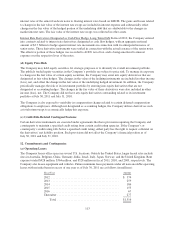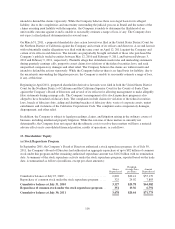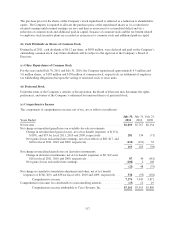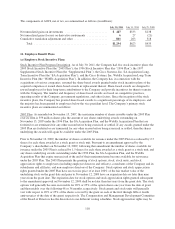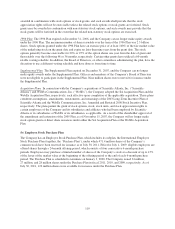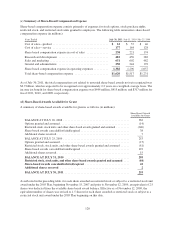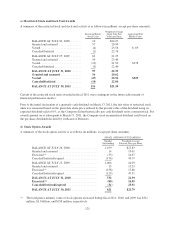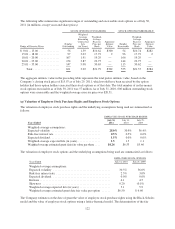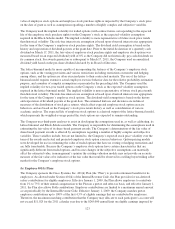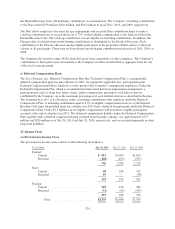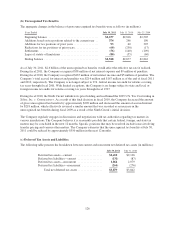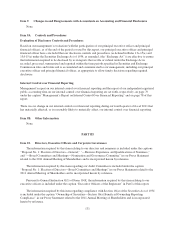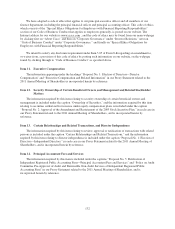Cisco 2011 Annual Report Download - page 131
Download and view the complete annual report
Please find page 131 of the 2011 Cisco annual report below. You can navigate through the pages in the report by either clicking on the pages listed below, or by using the keyword search tool below to find specific information within the annual report.value of employee stock options and employee stock purchase rights is impacted by the Company’s stock price
on the date of grant as well as assumptions regarding a number of highly complex and subjective variables.
The Company used the implied volatility for traded options (with contract terms corresponding to the expected
life of the employee stock purchase rights) on the Company’s stock as the expected volatility assumption
required in the Black-Scholes model. The implied volatility is more representative of future stock price trends
than historical volatility. The risk-free interest rate assumption is based upon observed interest rates appropriate
for the term of the Company’s employee stock purchase rights. The dividend yield assumption is based on the
history and expectation of dividend payouts at the grant date. Prior to the initial declaration of a quarterly cash
dividend on March 17, 2011, the fair value of employee stock purchase rights and employee stock options was
measured based on an expected dividend yield of 0% as the Company did not historically pay cash dividends on
its common stock. For awards granted on or subsequent to March 17, 2011, the Company used an annualized
dividend yield based on the per-share dividend declared by its Board of Directors.
The lattice-binomial model is more capable of incorporating the features of the Company’s employee stock
options, such as the vesting provisions and various restrictions including restrictions on transfer and hedging,
among others, and the options are often exercised prior to their contractual maturity. The use of the lattice-
binomial model requires extensive actual employee exercise behavior data for the relative probability estimation
purpose, and a number of complex assumptions as presented in the preceding table. The Company used the
implied volatility for two-year traded options on the Company’s stock as the expected volatility assumption
required in the lattice-binomial model. The implied volatility is more representative of future stock price trends
than historical volatility. The risk-free interest rate assumption is based upon observed interest rates appropriate
for the term of the Company’s employee stock options. The dividend yield assumption is based on the history
and expectation of dividend payouts at the grant date. The estimated kurtosis and skewness are technical
measures of the distribution of stock price returns, which affect expected employee stock option exercise
behaviors, and are based on the Company’s stock price return history as well as consideration of various
academic analyses. The expected life of employee stock options is a derived output of the lattice-binomial model,
which represents the weighted-average period the stock options are expected to remain outstanding.
The Company uses third-party analyses to assist in developing the assumptions used in, as well as calibrating, its
lattice-binomial and Black-Scholes models. The Company is responsible for determining the assumptions used in
estimating the fair value of its share-based payment awards. The Company’s determination of the fair value of
share-based payment awards is affected by assumptions regarding a number of highly complex and subjective
variables. These variables include, but are not limited to, the Company’s expected stock price volatility over the
term of the awards and actual and projected employee stock option exercise behaviors. Option-pricing models
were developed for use in estimating the value of traded options that have no vesting or hedging restrictions and
are fully transferable. Because the Company’s employee stock options have certain characteristics that are
significantly different from traded options, and because changes in the subjective assumptions can materially
affect the estimated value, in management’s opinion the existing valuation models may not provide an accurate
measure of the fair value or be indicative of the fair value that would be observed in a willing buyer/willing seller
market for the Company’s employee stock options.
(h) Employee 401(k) Plans
The Company sponsors the Cisco Systems, Inc. 401(k) Plan (the “Plan”) to provide retirement benefits for its
employees. As allowed under Section 401(k) of the Internal Revenue Code, the Plan provides for tax-deferred
salary contributions for eligible employees. Effective January 1, 2009, the Plan allows employees to contribute
from 1% to 75% of their annual compensation to the Plan on a pretax and after-tax basis, and effective January 1,
2011, the Plan also allows Roth contributions. Employee contributions are limited to a maximum annual amount
as set periodically by the Internal Revenue Code. Effective January 1, 2009, the Company matches pretax
employee contributions up to 100% of the first 4.5% of eligible earnings that are contributed by employees.
Therefore, the maximum matching contribution that the Company may allocate to each participant’s account will
not exceed $11,025 for the 2011 calendar year due to the $245,000 annual limit on eligible earnings imposed by
123


